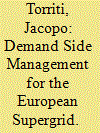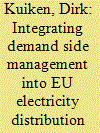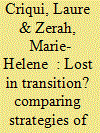|
|
|
Sort Order |
|
|
|
Items / Page
|
|
|
|
|
|
|
| Srl | Item |
| 1 |
ID:
125770


|
|
|
|
|
| Publication |
2013.
|
| Summary/Abstract |
The growing energy consumption in the residential sector represents about 30% of global demand. This calls for Demand Side Management solutions propelling change in behaviors of end consumers, with the aim to reduce overall consumption as well as shift it to periods in which demand is lower and where the cost of generating energy is lower. Demand Side Management solutions require detailed knowledge about the patterns of energy consumption. The profile of electricity demand in the residential sector is highly correlated with the time of active occupancy of the dwellings; therefore in this study the occupancy patterns in Spanish properties was determined using the 2009-2010 Time Use Survey (TUS), conducted by the National Statistical Institute of Spain. The survey identifies three peaks in active occupancy, which coincide with morning, noon and evening. This information has been used to input into a stochastic model which generates active occupancy profiles of dwellings, with the aim to simulate domestic electricity consumption. TUS data were also used to identify which appliance-related activities could be considered for Demand Side Management solutions during the three peaks of occupancy.
|
|
|
|
|
|
|
|
|
|
|
|
|
|
|
|
| 2 |
ID:
171364


|
|
|
|
|
| Summary/Abstract |
Realizing the full potential of a smart grid is contingent on the residential users’ acceptance of new technologies and the behavioural changes that will follow their implementation. Thus, the present research attempted to gain an insight into the factors that drive residential electricity consumers, particularly those with low income, towards or away from demand side management and distributed energy resources. The results of a consumer survey of 207 Japanese households revealed that there is a clear correlation between low-household income and the willingness of the respondents to reduce their energy expenditures. In contrast, the fear of the perceived additional cost required to implement these technologies, and the belief that consumers have inadequate information or support from the utility company, prevents them from adopting new technologies. Further, the results of a comparative analysis indicate that the reputation of the utility company is higher among smart grid users than traditional electricity consumers. The K-means clustering algorithm and hierarchical cluster analysis indicated that younger and poorer members of the society faced more barriers than middle age wealthier groups. The authors maintain that the electricity utilities thus need to develop a range of measures to engage residential consumers with heterogeneous socio-economic characteristics.
|
|
|
|
|
|
|
|
|
|
|
|
|
|
|
|
| 3 |
ID:
112302


|
|
|
|
|
| Publication |
2012.
|
| Summary/Abstract |
The prospect of a European Supergrid calls for research on aggregate electricity peak demand and Europe-wide Demand Side Management. No attempt has been made as yet to represent a time-related demand curve of residential electricity consumption at the European level. This article assesses how active occupancy levels of single-person households vary in single-person household in 15 European countries. It makes use of occupancy time-series data from the Harmonised European Time Use Survey database to build European occupancy curves; identify peak occupancy periods; construct time-related electricity demand curves for TV and video watching activities and assess occupancy variances of single-person households.
|
|
|
|
|
|
|
|
|
|
|
|
|
|
|
|
| 4 |
ID:
110755


|
|
|
|
|
| Publication |
2011.
|
| Summary/Abstract |
Within the next years, consumer households will be increasingly equipped with smart metering and intelligent appliances. These technologies are the basis for households to better monitor electricity consumption and to actively control loads in private homes. Demand side management (DSM) can be adopted to private households. We present a simulation model that generates household load profiles under flat tariffs and simulates changes in these profiles when households are equipped with smart appliances and face time-based electricity prices.
We investigate the impact of smart appliances and variable prices on electricity bills of a household. We show that for households the savings from equipping them with smart appliances are moderate compared to the required investment. This finding is quite robust with respect to variation of tariff price spreads and to different types of appliance utilization patterns.
Finally, our results indicate that electric utilities may face new demand peaks when day-ahead hourly prices are applied. However, a considerable amount of residential load is available for shifting, which is interesting for the utilities to balance demand and supply.
|
|
|
|
|
|
|
|
|
|
|
|
|
|
|
|
| 5 |
ID:
128448


|
|
|
|
|
| Publication |
2014.
|
| Summary/Abstract |
Demand side management (DSM) in electricity markets could improve energy efficiency and achieve environmental targets through controlled consumption. For the past 10 years or so DSM programmes have registered significant results. However, detailed analysis of its real impact as observed by a large number of pilot studies suggests that such programmes need to be fine-tuned to suit clearly identified conditions. This study aims to provide recommendations for the instruments to be used to prompt demand response with a view to maximizing energy and environmental efficiencies of various countries. The present study suggests that different DSM models should be deployed depending on the specific generation mix in any given country. Beside the natural benefits from cross-borders infrastructures, DSM improves the flexibility and reliability of the energy system, absorbing some shock on generation mix. We show efficiency increases with demand response but at a decreasing rate. So, according to rebound and report effects, simple DSM tools could be preferred.
|
|
|
|
|
|
|
|
|
|
|
|
|
|
|
|
| 6 |
ID:
180857


|
|
|
|
|
| Summary/Abstract |
With the rise in cooling demand and the permeation of decentralised renewable energy resources in electricity networks, electricity demand-side management (DSM) has become a major tool for electricity planning and decarbonisation in the Global South. In India, the commercial application of DSM is not new, yet utility-driven residential-scale demand response (DR) remains an unexplored area. This paper contributes on two fronts – to explicate householders and practitioner's perceptions of DR: disjunctions between these perceptions and its implications for the acceptance of residential DR. Using a co-production approach, this paper draws insights from two sets of stakeholders in India - 25 DR policy and utility experts and 24 household consumers. Our results show that technological saviourism pervasively underscores practitioners understanding of DR and householder agency, a crucial factor in the adoption of DR at the residential scale remains a missing piece. The paper concludes that without considering householder agency, delivering a decarbonised future based on demand response will be challenging and consumers may remain locked into-existing socio-cultural practices that negate the adoption of DR.
|
|
|
|
|
|
|
|
|
|
|
|
|
|
|
|
| 7 |
ID:
176656


|
|
|
|
|
| Summary/Abstract |
Trials of technologies designed to promote residential demand-side energy management (DSM) have found aggregate levels of load-shifting behaviour and curtailment in energy use. These aggregate data, however, mask considerable differences in people's engagement in DSM at an individual household level. We present the findings of a quantitative exploration of people's intentions to use a home energy management system (HEMS) for residential DSM in the United Kingdom. The technology acceptance model (TAM) was used in conjunction with constructs measuring psychological empowerment and environmental attitudes to explore participants' acceptance of a HEMS to facilitate load-shifting. Findings from a mediation analysis showed perceptions of the usefulness of the HEMS and its ease of use were important predictors of people's intentions to use one. They also highlight a potential conflict between an individual's home energy consumption goals and national DSM goals. The implications of these findings for understanding end-user acceptance of HEMS are discussed. We conclude that seeking opportunities to promote shared, internalised goals for residential DSM may be an avenue for increasing the uptake and use of technologies designed to enable load-shifting (and other energy conservation behaviours) among end-users.
|
|
|
|
|
|
|
|
|
|
|
|
|
|
|
|
| 8 |
ID:
117227


|
|
|
|
|
| Publication |
2013.
|
| Summary/Abstract |
This paper explores the possible evolution of UK electricity demand as we move along three potential transition pathways to a low carbon economy in 2050. The shift away from fossil fuels through the electrification of demand is discussed, particularly through the uptake of heat pumps and electric vehicles in the domestic and passenger transport sectors. Developments in the way people and institutions may use energy along each of the pathways are also considered and provide a rationale for the quantification of future annual electricity demands in various broad sectors. The paper then presents detailed modelling of hourly balancing of these demands in the context of potential low carbon generation mixes associated with the three pathways. In all cases, hourly balancing is shown to be a significant challenge. To minimise the need for conventional generation to operate with very low capacity factors, a variety of demand side participation measures are modelled and shown to provide significant benefits. Lastly, projections of operational greenhouse gas emissions from the UK and the imports of fossil fuels to the UK for each of the three pathways are presented.
|
|
|
|
|
|
|
|
|
|
|
|
|
|
|
|
| 9 |
ID:
129921


|
|
|
| 10 |
ID:
177354


|
|
|
|
|
| Summary/Abstract |
The study investigates the preferences for Demand Side Management programs for electricity usage in Poland. Using stated preference data generated from a choice experiment with a large representative sample of the Polish population, we estimate willingness to accept changes in electricity consumption. We also explore the impact of social comparison of households’ energy use on the acceptance of Demand Side Management as a potential driver of preference heterogeneity with respect to electricity services.
|
|
|
|
|
|
|
|
|
|
|
|
|
|
|
|
| 11 |
ID:
166563


|
|
|
|
|
| Summary/Abstract |
The EU goals for renewable electricity cause significant changes of electrical loads in distribution systems, in which most renewable electricity sources are integrated. This poses a challenge for distribution system operators (DSOs) as their networks are not designed for such load changes. DSOs could use networks more efficiently with demand side management (DSM), where consumers of electricity alter their consumption patterns, shifting (production/consumption) loads in the distribution system. In such a setting, consumers would trade DSM services with the DSOs. However, currently, DSOs follow the ‘copper plate approach’, which assumes the system should have sufficient capacity to ensure that the desired volumes of electricity can be transported. This seeks to guarantee regulated third party access (rTPA) for all system users. Next to rTPA, based on regulated tasks, DSOs should ensure secure, reliable and efficient systems. In doing so, the DSOs are bound by unbundling requirements, which do not allow them to be involved in any activities other than those related to distribution. Therefore, especially production and supply are not allowed. Still, it seems debatable whether EU law allows DSOs to apply DSM, as it has an impact on both the access conditions to the electricity system, and the production, supply and trade of electricity. This article further analyses how DSM relates to the legal framework of DSOs, which obstacles are present, and how DSM could be traded between DSOs and system users.
|
|
|
|
|
|
|
|
|
|
|
|
|
|
|
|
| 12 |
ID:
137708


|
|
|
|
|
| Summary/Abstract |
This paper examines the notion of energy transition when implemented by private utilities. In 2000, the Delhi government privatized electricity distribution to three private distribution companies. Most research was concerned with the impact of privatization on energy reliability, tariff settings and regulation issues. This paper looks at two under-researched themes: the expansion of services to poorer neighborhoods and the rollout of clean energy policies. This focus allows to unpack the materiality of socio-technical systems, to analyze how energy infrastructures are being technically deployed on the ground and to identify which social approach is used. To detail the specific practices of each company provides a more nuanced and accurate understanding of the reform. In-depth analysis of the three private utilities show that they interpret the reform mandate differently: they use a varied range of technical tools; they respond differently to social concerns in poorer neighborhoods; and they have distinctive internal management choices and corporate cultures. All these four factors can strengthen or undermine the transition towards increased access and clean energy.
|
|
|
|
|
|
|
|
|
|
|
|
|
|
|
|
| 13 |
ID:
128384


|
|
|
|
|
| Publication |
2014.
|
| Summary/Abstract |
The Ministry of Energy and Mines of Nicaragua (MEM) is planning to launch in 2013 a massive replacement program of 2 million incandescent lamps with compact fluorescent lamps (CFLs). This paper explores the expected impacts on a 10 year basis (2013-2023) using cost/benefit analysis for consumers, utility and society. Market conditions for introduction of a 7 W LED in the residential sector were also analyzed. Three prospective scenarios were considered in order to estimate the impact of CFLs penetration. Finally, the analysis is complemented with laboratory tests for eight lamps-three CFLs of the pilot program batch and one incandescent lamp 75 W; three CFLs and a 7 W LED available in the national market. Results supports that for countries like Nicaragua with an energy matrix still dependent on imported petroleum, energy efficiency programs are especially positive in economic and environmental terms. However, it is necessary to implement and to test CFLs programs requirements about high power factor (PF=0.9) and low total harmonic distortion (THD=20%).
|
|
|
|
|
|
|
|
|
|
|
|
|
|
|
|
| 14 |
ID:
104982


|
|
|
|
|
| Publication |
2011.
|
| Summary/Abstract |
Peak demand on electricity grids is a growing problem that increases costs and risks to supply security. Residential sector loads often contribute significantly to seasonal and daily peak demand. Demand response projects aim to manage peak demand by applying price signals and automated load shedding technologies. This research investigates voluntary load shedding in response to information about the security of supply, the emission profile and the cost of meeting critical peak demand in the customers' network. Customer willingness to change behaviour in response to this information was explored through mail-back survey. The diversified demand modelling method was used along with energy audit data to estimate the potential peak load reduction resulting from the voluntary demand response. A case study was conducted in a suburb of Christchurch, New Zealand, where electricity is the main source for water and space heating. On this network, all water heating cylinders have ripple-control technology and about 50% of the households subscribe to differential day/night pricing plan. The survey results show that the sensitivity to supply security is on par with price, with the emission sensitivity being slightly weaker. The modelling results show potential 10% reduction in critical peak load for aggregate voluntary demand response.
|
|
|
|
|
|
|
|
|
|
|
|
|
|
|
|
| 15 |
ID:
177112


|
|
|
|
|
| Summary/Abstract |
Industrial demand response can play an important part in balancing the intermittent production from a growing share of renewable energies in electricity markets. This paper analyses the role of aggregators – intermediaries between participants and power markets – in facilitating industrial demand response. Based on the results from semi-structured interviews with German demand response aggregators, as well as a wider stakeholder online survey, we examine the role of aggregators in overcoming barriers to industrial demand response. We find that a central role for aggregators is to raise awareness for the potentials of demand response, as well as to support implementation by engaging key actors in industrial companies. Moreover, we develop a taxonomy that helps analyse how the different functional roles of aggregators create economic value. We find that there is considerable heterogeneity in the kind of services that aggregators offer, many of which do create significant economic value. However, some of the functional roles that aggregators currently fill may become obsolete once market barriers to demand response are reduced or knowledge on demand response becomes more diffused.
|
|
|
|
|
|
|
|
|
|
|
|
|
|
|
|
| 16 |
ID:
176850


|
|
|
|
|
| Summary/Abstract |
Given the growing share of uncertain renewable energy production, the energy transition challenges modern power systems and especially calls for increased flexibility. However, relevant information on the highly asset-specific flexibility potential is typically only known to plant operators themselves and not, e.g., to transmission system operators. Therefore, liberalized electricity markets use prices that set explicit monetary incentives to disclose the relevant private information about the market participants’ assets. In this way, information asymmetries may be reduced. Given the different challenges of an integration of renewables, we argue that the associated new forms of volatile power profiles require new forms of power-trading products. In particular, based on recent advances in technical power measurement and billing, individual and market participant-specific power profiles may be superior to the current trading of average volumes. Against this background, we first outline various evolutionary adjustments of existing power-trading products and their underlying product parameters including (1) strengthening local pricing, (2) finer temporal granularity, (3) smaller minimum volume, and (4) shorter gate-closure time. Second, we open up a new perspective in form of a more disruptive shift towards power-profile trade, where market participants define their trading product using the actual power profile as a new product parameter.
|
|
|
|
|
|
|
|
|
|
|
|
|
|
|
|
| 17 |
ID:
127874


|
|
|
|
|
| Publication |
2014.
|
| Summary/Abstract |
We review long-term electric utility plans representing ~90% of generation within the Western U.S. and Canadian provinces. We address what utility planners assume about future growth of electricity demand and supply; what types of risk they consider in their long-term resource planning; and the consistency in which they report resource planning-related data. The region is anticipated to grow by 2% annually by 2020 - before Demand Side Management. About two-thirds of the utilities that provided an annual energy forecast also reported energy efficiency savings projections; in aggregate, they anticipate an average 6.4% reduction in energy and 8.6% reduction in peak demand by 2020. New natural gas-fired and renewable generation will replace retiring coal plants. Although some utilities anticipate new coal-fired plants, most are planning for steady growth in renewable generation over the next two decades. Most planned solar capacity will come online before 2020, with most wind expansion after 2020. Fuel mix is expected to remain ~55% of total generation. Planners consider a wide range of risks but focus on future demand, fuel prices, and the possibility of GHG regulations. Data collection and reporting inconsistencies within and across electric utility resource plans lead to recommendations on policies to address this issue.
|
|
|
|
|
|
|
|
|
|
|
|
|
|
|
|
|
|
|
|
|